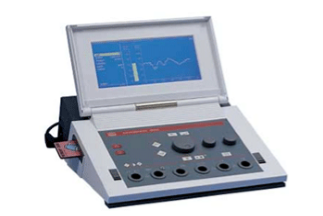18.5: Electrotherapy
- Page ID
- 15686
As with all evidence based practices, the strength of the research methodology is paramount when selecting a treatment modality. Differing patient populations, protocols and outcome measures make clear guidelines difficult. Electrotherapy should not be considered as a single treatment option, but the next level of conservative management. Different settings on the equipment can select for slow or fast twitch neuromuscular activation. EMG in combination with NMS allows accurate feedback of response to stimulation.
EMG biofeedback
Electromyography (EMG) is the undisputed gold standard of biofeedback. Ideally, it shows a range of work over a period of time, allowing assessment of:
- Maximum/minimum contraction
- Maximum/minimum relaxation
- Stability contraction/relaxation
- Speed of initiation/release
- Endurance and fatigue resistance
- Concentric and eccentric control
EMG is best performed with a shaped vaginal (or anal) electrode. It may used across a range of PF tonal abnormalities from the upscaling of a PF contraction to the down-regulating of high resting tone. \

Figure \(\PageIndex{1}\): A neuromuscular stimulation unit – The Myomed 932
Neuromuscular Stimulation
Where the PF has a strength of less than Grade 3, or has very poor sensory awareness (pudendal nerve latencies), neuromuscular electrical stimulation is indicated. Electrical impulses set up an action potential in the pudendal nerve, causing it to fire and contract the PF. This improves nerve conduction, activates the neuromuscular junction and stimulates a muscle contraction. It also promotes synapse formation, protein production and muscle hypertrophy. Depending upon the symptoms and aims of treatment, the settings are selected according to wavelength and frequency. A classic ‘fast twitch’ training would include active assisted contractions with the machine (NMS) for speed and strength. A classic ‘slow twitch’ treatment would be passive and would improve sensory conduction, resting tone and normalize bladder reflexes.
Conclusion
The pelvic floor physiotherapist has the necessary skills to assess muscle function and dysfunction and rehab according to sound evidence based principles. Highly developed palpation is needed to differentiate between subtle differences in tone and strength. We are, essentially, working blind! Special insight into the psychological implications and management of behaviour make the Pelvic Floor Physio an excellent conservative one-stop-shop.
A clear assessment, with a patient specific programme and regular monitoring of compliance and motivation can yield excellent results; better than standing in the corner doing 100 squeezes per day, but not contracting with a cough!
Physiotherapy for pelvic floor disorders does not compete with medication or surgery. It finds its niche somewhere between patient responsibility and doing the best you can with what you’ve got.


